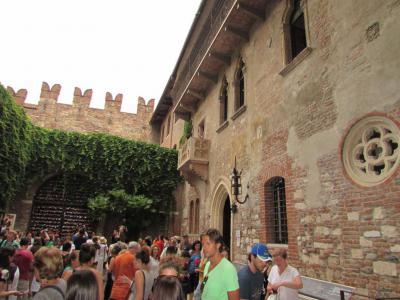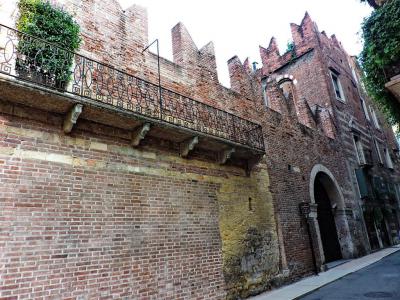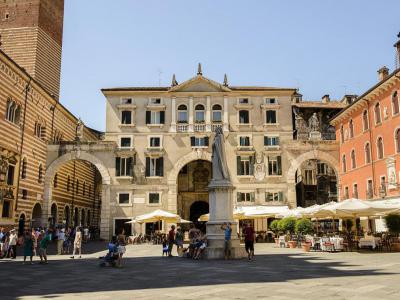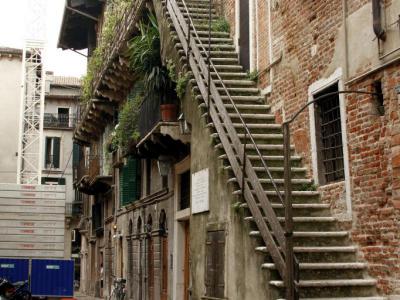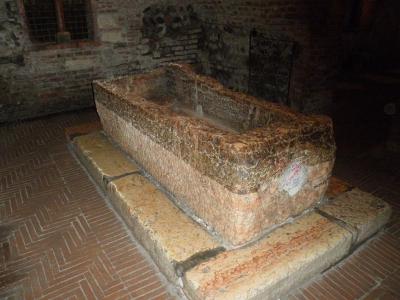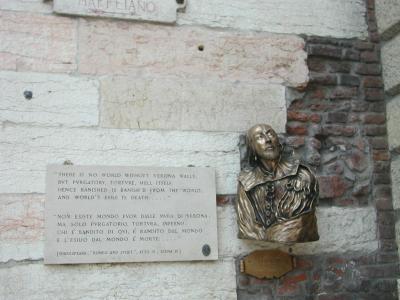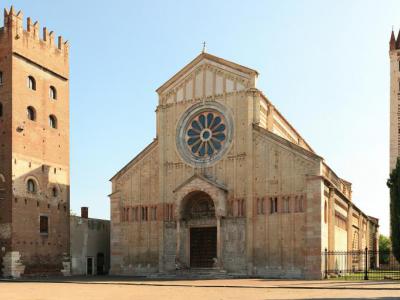Audio Guide: Romeo and Juliet Tour (Self Guided), Verona
Few cities in the world capture romance like Verona, the setting that inspired Shakespeare’s Romeo and Juliet. Each year, thousands of visitors stroll the cobbled streets, imagining the star-crossed lovers meeting under moonlight. For romantics, literature enthusiasts, and curious travelers, the Romeo and Juliet Tour offers an unforgettable journey through history, myth, and passion.
Long before Shakespeare penned his play in the late 16th century, stories of tragic young lovers circulated in Italy. The earliest known version appeared in the 1470s, written by Masuccio Salernitano. In the early 1500s, Luigi da Porto adapted the tale explicitly to Verona, naming the lovers Romeo Montecchi and Giulietta Capuleti. His version introduced the feuding families, secret marriage, and tragic tomb ending. Later, Matteo Bandello refined the story, and Arthur Brooke translated it into English as The Tragical History of Romeus and Juliet in 1562, which directly inspired Shakespeare.
Shakespeare transformed the tale into a timeless masterpiece, bringing vivid characters, lyrical language, and deep exploration of love, fate, and conflict. Although he never visited Verona, his play forever linked the city with the story, turning local legend into international cultural heritage. Over centuries, landmarks like Juliet’s House, Romeo’s House, and Juliet’s Tomb became pilgrimage sites, while statues, plaques, and museums celebrate both the city’s history and its mythical connection to the lovers who “never were” yet live on in imagination.
The tour begins at Juliet’s House, a 13th-century residence featuring the famous balcony. Visitors can explore the small museum, leave love notes on the courtyard wall, or touch the bronze statue of Juliet for good luck. Nearby is Romeo’s House, a medieval building linked to the Montecchi family, whose exterior evokes the secrecy and tension of Shakespeare’s tale. The Scaligeri Tombs, magnificent Gothic monuments to Verona’s medieval rulers, reflect the city’s grandeur and turbulent history.
No visit is complete without Juliet’s Tomb, in the crypt of the former Capuchin convent of San Francesco al Corso, and the nearby William Shakespeare Bust and Plaque, honoring the playwright who immortalized Verona in literature.
By the end of the tour, it becomes clear that Verona is more than a setting — it is a living monument to love, where history, literature, and legend blend seamlessly. Every balcony, archway, and whisper of the past keeps the story of Romeo and Juliet alive, eternal, and heartbreakingly human.
Long before Shakespeare penned his play in the late 16th century, stories of tragic young lovers circulated in Italy. The earliest known version appeared in the 1470s, written by Masuccio Salernitano. In the early 1500s, Luigi da Porto adapted the tale explicitly to Verona, naming the lovers Romeo Montecchi and Giulietta Capuleti. His version introduced the feuding families, secret marriage, and tragic tomb ending. Later, Matteo Bandello refined the story, and Arthur Brooke translated it into English as The Tragical History of Romeus and Juliet in 1562, which directly inspired Shakespeare.
Shakespeare transformed the tale into a timeless masterpiece, bringing vivid characters, lyrical language, and deep exploration of love, fate, and conflict. Although he never visited Verona, his play forever linked the city with the story, turning local legend into international cultural heritage. Over centuries, landmarks like Juliet’s House, Romeo’s House, and Juliet’s Tomb became pilgrimage sites, while statues, plaques, and museums celebrate both the city’s history and its mythical connection to the lovers who “never were” yet live on in imagination.
The tour begins at Juliet’s House, a 13th-century residence featuring the famous balcony. Visitors can explore the small museum, leave love notes on the courtyard wall, or touch the bronze statue of Juliet for good luck. Nearby is Romeo’s House, a medieval building linked to the Montecchi family, whose exterior evokes the secrecy and tension of Shakespeare’s tale. The Scaligeri Tombs, magnificent Gothic monuments to Verona’s medieval rulers, reflect the city’s grandeur and turbulent history.
No visit is complete without Juliet’s Tomb, in the crypt of the former Capuchin convent of San Francesco al Corso, and the nearby William Shakespeare Bust and Plaque, honoring the playwright who immortalized Verona in literature.
By the end of the tour, it becomes clear that Verona is more than a setting — it is a living monument to love, where history, literature, and legend blend seamlessly. Every balcony, archway, and whisper of the past keeps the story of Romeo and Juliet alive, eternal, and heartbreakingly human.
How it works: Download the app "GPSmyCity: Walks in 1K+ Cities" from Apple App Store or Google Play Store to your mobile phone or tablet. The app turns your mobile device into a personal tour guide and its built-in GPS navigation functions guide you from one tour stop to next. The app works offline, so no data plan is needed when traveling abroad.
Romeo and Juliet Tour Map
Guide Name: Romeo and Juliet Tour
Guide Location: Italy » Verona (See other walking tours in Verona)
Guide Type: Self-guided Walking Tour (Sightseeing)
# of Attractions: 8
Tour Duration: 2 Hour(s)
Travel Distance: 3.9 Km or 2.4 Miles
Author: Helen
Sight(s) Featured in This Guide:
Guide Location: Italy » Verona (See other walking tours in Verona)
Guide Type: Self-guided Walking Tour (Sightseeing)
# of Attractions: 8
Tour Duration: 2 Hour(s)
Travel Distance: 3.9 Km or 2.4 Miles
Author: Helen
Sight(s) Featured in This Guide:
- Casa de Giulietta (House of Juliet)
- Casa di Romeo (House of Romeo)
- Arche Scaligere (Scaligeri Tombs)
- Piazza dei Signori (Lords Square)
- Volto Barbaro (Barbarian Face Passage)
- Juliet's Tomb
- William Shakespeare Bust and Plaque
- Basilica di San Zeno Maggiore (San Zeno Maggiore Church)
1) Casa de Giulietta (House of Juliet) (must see)
The House of Juliet is one of the most famous landmarks associated with William Shakespeare’s Romeo and Juliet, often visited by those seeking to experience the legendary romance between Juliet Capulet and Romeo Montague. Though the story is fictional, the house itself has become a symbol of love and tragedy, drawing countless visitors who are eager to connect with Verona’s most romantic tale.
The house dates back to the 13th century and is believed to have belonged to the Cappelletti family, traditionally linked to Juliet’s fictional lineage. The most famous feature of the house is its balcony, now an enduring emblem of Juliet’s longing in the play. Visitors often picture the moment when Romeo whispers his devotion from below. Although the balcony itself was added during restoration in the 20th century, it remains one of the city’s most photographed sights and a key highlight for fans of Shakespeare’s work.
The building is a fine example of medieval architecture, featuring Gothic elements, a brick façade, and intricately carved details. In the courtyard, a bronze statue of Juliet stands beneath the balcony, and the tradition of rubbing its right breast for good luck in love has made it a popular spot for photos. The walls nearby are covered with love messages, notes, and padlocks left by couples hoping for lasting affection.
Inside, the house has been transformed into a museum, displaying period furnishings, costumes used in film adaptations, and exhibits about the cultural impact of Shakespeare’s tragic story. From its romantic folklore to its historical roots, the House of Juliet continues to inspire visitors from around the world with the enduring power of love and imagination.
The house dates back to the 13th century and is believed to have belonged to the Cappelletti family, traditionally linked to Juliet’s fictional lineage. The most famous feature of the house is its balcony, now an enduring emblem of Juliet’s longing in the play. Visitors often picture the moment when Romeo whispers his devotion from below. Although the balcony itself was added during restoration in the 20th century, it remains one of the city’s most photographed sights and a key highlight for fans of Shakespeare’s work.
The building is a fine example of medieval architecture, featuring Gothic elements, a brick façade, and intricately carved details. In the courtyard, a bronze statue of Juliet stands beneath the balcony, and the tradition of rubbing its right breast for good luck in love has made it a popular spot for photos. The walls nearby are covered with love messages, notes, and padlocks left by couples hoping for lasting affection.
Inside, the house has been transformed into a museum, displaying period furnishings, costumes used in film adaptations, and exhibits about the cultural impact of Shakespeare’s tragic story. From its romantic folklore to its historical roots, the House of Juliet continues to inspire visitors from around the world with the enduring power of love and imagination.
2) Casa di Romeo (House of Romeo)
The House of Romeo is a 13th-century brick residence often linked to the Montague family from Shakespeare’s Romeo and Juliet. In reality, the building historically belonged to the noble Nogarola family, but its medieval appearance and location near Juliet’s House have made it part of Verona’s romantic storytelling.
With its fortified walls and tower-like structure, the home reflects the architectural style of noble residences from a period marked by family rivalries and political tension. These defensive features recall the bitter factional conflicts that once divided Verona into two opposing political groups: the Guelphs and the Ghibellines — the very type of feud Shakespeare drew upon for his tragedy.
Unlike Juliet’s House, the House of Romeo is privately owned and cannot be visited inside. Visitors typically admire the exterior from the narrow street outside the entrance, where the building’s castle-like presence evokes the turbulent atmosphere that inspired Shakespeare’s drama. A small relief of a stylized coat of arms can be seen above the entrance, a reminder of the noble family that once lived within.
Next to the residence is La Taverna di Romeo restaurant, where visitors often stop for a meal or drink — not to enter the house itself, but to enjoy the surrounding ambience. Some regional dishes include traditional Veronese specialties such as horse or donkey meat.
By the 19th century, Romantic-era travelers were already seeking out places linked to the Shakespeare’s play, helping cement the building’s modern identity. Today, the House of Romeo remains a symbolic stop for those exploring the city of love — a modest yet atmospheric reminder of the enduring power of literature layered onto real medieval history.
With its fortified walls and tower-like structure, the home reflects the architectural style of noble residences from a period marked by family rivalries and political tension. These defensive features recall the bitter factional conflicts that once divided Verona into two opposing political groups: the Guelphs and the Ghibellines — the very type of feud Shakespeare drew upon for his tragedy.
Unlike Juliet’s House, the House of Romeo is privately owned and cannot be visited inside. Visitors typically admire the exterior from the narrow street outside the entrance, where the building’s castle-like presence evokes the turbulent atmosphere that inspired Shakespeare’s drama. A small relief of a stylized coat of arms can be seen above the entrance, a reminder of the noble family that once lived within.
Next to the residence is La Taverna di Romeo restaurant, where visitors often stop for a meal or drink — not to enter the house itself, but to enjoy the surrounding ambience. Some regional dishes include traditional Veronese specialties such as horse or donkey meat.
By the 19th century, Romantic-era travelers were already seeking out places linked to the Shakespeare’s play, helping cement the building’s modern identity. Today, the House of Romeo remains a symbolic stop for those exploring the city of love — a modest yet atmospheric reminder of the enduring power of literature layered onto real medieval history.
3) Arche Scaligere (Scaligeri Tombs)
The Scaliger Tombs form one of Verona’s most prominent Gothic ensembles. These five funerary monuments commemorate the Scaligeri family, who ruled Verona during the 13th and 14th centuries. While often associated with Shakespeare’s Romeo and Juliet, the idea that this was the location of Juliet’s staged death belongs to literary tradition rather than documented history.
The tombs stand in a small, gated courtyard beside the Church of Santa Maria Antica, the family’s private chapel. Their design resembles elaborate Gothic tabernacles: each features a highly carved sarcophagus and a canopy, with the deceased depicted on horseback in full armor symbolizing power and leadership.
The rise of these monuments reflects the political ascent of the Scaligeri. Mastino I della Scala secured control over Verona in 1259, earning his family hereditary authority. Yet, as in many medieval dynasties, internal rivalries eventually led to their downfall — an echo of the dramatic themes that later inspired Shakespeare’s storytelling.
Celebrated as some of the finest examples of Gothic funerary architecture in Italy, the Scaliger Tombs remain a powerful reminder of the family who shaped Verona’s medieval history and left a legacy visible in the city’s towers, fortifications, and political memory.
The tombs stand in a small, gated courtyard beside the Church of Santa Maria Antica, the family’s private chapel. Their design resembles elaborate Gothic tabernacles: each features a highly carved sarcophagus and a canopy, with the deceased depicted on horseback in full armor symbolizing power and leadership.
The rise of these monuments reflects the political ascent of the Scaligeri. Mastino I della Scala secured control over Verona in 1259, earning his family hereditary authority. Yet, as in many medieval dynasties, internal rivalries eventually led to their downfall — an echo of the dramatic themes that later inspired Shakespeare’s storytelling.
Celebrated as some of the finest examples of Gothic funerary architecture in Italy, the Scaliger Tombs remain a powerful reminder of the family who shaped Verona’s medieval history and left a legacy visible in the city’s towers, fortifications, and political memory.
4) Piazza dei Signori (Lords Square) (must see)
Signori Square has long been one of Verona’s most elegant public spaces, surrounded by grand palaces that once housed the city’s rulers. Also called Lords Square, it reflects the political heart of medieval Verona, where the Scaligeri family governed during the city’s most powerful era. The square is also tied to the legacy of Romeo and Juliet: here stood the seat of government where Bartolomeo della Scala banished the fictional Romeo to Mantua.
At the square’s center rises a statue of Dante Alighieri, installed in 1865 to mark the 600th anniversary of the poet’s birth. Exiled from Florence, Dante found refuge in Verona under the Scaligeri — a key period in which he continued writing the Divine Comedy.
Several important buildings stand along the square. The Ragione Palace, once Verona’s town hall, and the Captain’s Palace, seat of the military governor during Venetian rule, both define the western side.
On the east side is the Portico of the Council, a landmark of Venetian Renaissance architecture where civic leaders once met beneath elegant arches. The Domus Nova Palace, dating to the 13th century, formerly housed the Chief Magistrate’s offices. Nearby stands the Podestà Palace, a former Scaliger residence later adapted for administrative use.
One of the most colorful façades belongs to the House of Charity, now home to Antico Caffè Dante, considered one of Verona’s oldest cafés. Today, Signori Square remains a refined setting for admiring centuries of political, artistic, and literary history — all gathered into one compact civic space.
At the square’s center rises a statue of Dante Alighieri, installed in 1865 to mark the 600th anniversary of the poet’s birth. Exiled from Florence, Dante found refuge in Verona under the Scaligeri — a key period in which he continued writing the Divine Comedy.
Several important buildings stand along the square. The Ragione Palace, once Verona’s town hall, and the Captain’s Palace, seat of the military governor during Venetian rule, both define the western side.
On the east side is the Portico of the Council, a landmark of Venetian Renaissance architecture where civic leaders once met beneath elegant arches. The Domus Nova Palace, dating to the 13th century, formerly housed the Chief Magistrate’s offices. Nearby stands the Podestà Palace, a former Scaliger residence later adapted for administrative use.
One of the most colorful façades belongs to the House of Charity, now home to Antico Caffè Dante, considered one of Verona’s oldest cafés. Today, Signori Square remains a refined setting for admiring centuries of political, artistic, and literary history — all gathered into one compact civic space.
5) Volto Barbaro (Barbarian Face Passage)
Just steps behind the colourful Mazzanti Houses lies the Barbarian Face Passage, a narrow vaulted alley dating back to the Middle Ages. This dimly lit corridor was once one of several shortcuts that helped merchants move efficiently through Verona’s busy market district. Its enclosed structure and centuries-old walls preserve the authentic atmosphere of the historic centre.
The origin of its name remains uncertain. Some believe it comes from a carved stone face — a “barbarian” mask — that once decorated the vault. Others suggest the name recalls foreign merchants and “outsiders” who frequented the marketplace. Whatever its source, the name enhances the alley’s mysterious character, making it a place where imagination easily takes hold.
The passage has been embraced in connection with Shakespeare’s Romeo and Juliet. A plaque on the façade of Carlotti Palace commemorates the fictional duel in which Tybalt kills Mercutio — the turning point that propels Romeo toward tragedy. The bronze relief depicts the dramatic scene and serves as a reminder of how literary legend has become embedded in Verona’s real urban fabric.
The plaque also acknowledges the earlier work of Matteo Bandello, a Lombard writer whose 16th-century novella told the story of two ill-fated Veronese lovers long before Shakespeare adapted the tale. His version helped shape the narrative that ultimately made Verona famous as the “city of love”.
The origin of its name remains uncertain. Some believe it comes from a carved stone face — a “barbarian” mask — that once decorated the vault. Others suggest the name recalls foreign merchants and “outsiders” who frequented the marketplace. Whatever its source, the name enhances the alley’s mysterious character, making it a place where imagination easily takes hold.
The passage has been embraced in connection with Shakespeare’s Romeo and Juliet. A plaque on the façade of Carlotti Palace commemorates the fictional duel in which Tybalt kills Mercutio — the turning point that propels Romeo toward tragedy. The bronze relief depicts the dramatic scene and serves as a reminder of how literary legend has become embedded in Verona’s real urban fabric.
The plaque also acknowledges the earlier work of Matteo Bandello, a Lombard writer whose 16th-century novella told the story of two ill-fated Veronese lovers long before Shakespeare adapted the tale. His version helped shape the narrative that ultimately made Verona famous as the “city of love”.
6) Juliet's Tomb
Located within the peaceful grounds of the Monastery of San Francesco al Corso lies Juliet’s Tomb, a site closely tied to the legend of Shakespeare’s Romeo and Juliet. This setting has become one of the most emotional stops for those drawn to Verona’s most famous lovers. Here, visitors can step into the dim, atmospheric crypt where Juliet is said to have lain in eternal slumber.
In the courtyard above, a bronze statue of Juliet stands as a gesture of everlasting love. Tradition says that touching the statue — especially placing a hand over her heart — brings good fortune in romance. Devoted couples often leave heartfelt notes or photos nearby.
The monastery complex offers far more than a legendary tomb. Its gardens, trellised paths, and historical halls form a graceful venue for weddings and commemorative events. Near the tomb, the beautiful Guarienti Hall displays artworks depicting scenes from the play, while the adjacent church is frequently imagined as the church where Romeo and Juliet were secretly married.
Adding cultural depth to the visit, the monastery is also home to the Museum of Frescoes, inaugurated in 1975. Inside, visitors can admire detached frescoes from Verona’s noble houses and churches dating from the Middle Ages to the 18th century, as well as Roman artifacts that connect this romantic site to the city’s ancient past. Seasonal theatrical performances, often reenacting scenes from Shakespeare’s masterpiece, animate the cloisters and terraces, making the story feel vividly alive.
Each February, Juliet’s Tomb becomes the heart of a special tradition: the “Dear Juliet” contest selects the most touching love letters sent from around the world, carried on the belief that Juliet’s spirit still listens to those in love.
Tip:
If you plan to visit Juliet’s House as well, consider a combined ticket — it offers convenient access to both of Verona’s romantic sites, and helps you follow the lovers’ story from balcony to tomb.
In the courtyard above, a bronze statue of Juliet stands as a gesture of everlasting love. Tradition says that touching the statue — especially placing a hand over her heart — brings good fortune in romance. Devoted couples often leave heartfelt notes or photos nearby.
The monastery complex offers far more than a legendary tomb. Its gardens, trellised paths, and historical halls form a graceful venue for weddings and commemorative events. Near the tomb, the beautiful Guarienti Hall displays artworks depicting scenes from the play, while the adjacent church is frequently imagined as the church where Romeo and Juliet were secretly married.
Adding cultural depth to the visit, the monastery is also home to the Museum of Frescoes, inaugurated in 1975. Inside, visitors can admire detached frescoes from Verona’s noble houses and churches dating from the Middle Ages to the 18th century, as well as Roman artifacts that connect this romantic site to the city’s ancient past. Seasonal theatrical performances, often reenacting scenes from Shakespeare’s masterpiece, animate the cloisters and terraces, making the story feel vividly alive.
Each February, Juliet’s Tomb becomes the heart of a special tradition: the “Dear Juliet” contest selects the most touching love letters sent from around the world, carried on the belief that Juliet’s spirit still listens to those in love.
Tip:
If you plan to visit Juliet’s House as well, consider a combined ticket — it offers convenient access to both of Verona’s romantic sites, and helps you follow the lovers’ story from balcony to tomb.
7) William Shakespeare Bust and Plaque
The bust of William Shakespeare, accompanied by a commemorative plaque, stands near the historic gates of Verona — a symbolic tribute to the playwright who immortalized the city through Romeo and Juliet. Set into the old stone walls leading toward Bra Square, this monument marks what was once the city’s primary entrance during medieval times. According to the story, when Romeo was punished for killing Tybalt, he would have been forced to leave Verona through these very gates, stepping into exile and away from Juliet forever.
The plaque features lines from Shakespeare’s tragedy, displayed in both English and Italian to honor Verona’s international audience. The quoted passage captures Romeo’s anguish at being banished from the city of his love: “There is no world without Verona walls. But purgatory, torture, hell itself. Hence banished is banished from the world. And world’s exile is death.”
The bronze bust, crafted in 2003 by local sculptor Sergio Pasetto, portrays Shakespeare with a thoughtful, upward gaze, as if contemplating the drama he set among Verona’s streets and palaces. Today, visitors often pause here to take photos, read the heartfelt inscription, and reflect on how a fictional love story helped shape Verona’s identity.
The plaque features lines from Shakespeare’s tragedy, displayed in both English and Italian to honor Verona’s international audience. The quoted passage captures Romeo’s anguish at being banished from the city of his love: “There is no world without Verona walls. But purgatory, torture, hell itself. Hence banished is banished from the world. And world’s exile is death.”
The bronze bust, crafted in 2003 by local sculptor Sergio Pasetto, portrays Shakespeare with a thoughtful, upward gaze, as if contemplating the drama he set among Verona’s streets and palaces. Today, visitors often pause here to take photos, read the heartfelt inscription, and reflect on how a fictional love story helped shape Verona’s identity.
8) Basilica di San Zeno Maggiore (San Zeno Maggiore Church) (must see)
The Basilica of Saint Zeno is deeply tied to the romantic legacy of Romeo and Juliet. Tradition holds that this is the church where Shakespeare imagined the young lovers’ secret wedding, a hopeful moment that briefly united the rival houses of Capulet and Montague before tragedy struck.
The Basilica stands on the site where Saint Zeno, Verona’s beloved patron and 8th bishop, was buried after his death in 371 AD. Its creamy tuff façade glows warmly in the daylight, while on the left, visitors can explore the elegant 13th-century cloister, once part of a Benedictine abbey. To the right rises the slender 12th-century bell tower.
Above the entrance is the famous rose window known as the Wheel of Fortune, designed by Master Briolato. Its rotating cycle of luck and loss reflects the dramatic twists of Shakespeare’s tale, where love, fate, and family honor collide. Beneath it, a set of bronze doors from the 12th century depict biblical narratives and local legends, including the famous episode of Saint Zeno performing an exorcism.
Inside, the church is adorned with frescoes ranging from the 12th to the 15th century. A 12th-century marble statue of Saint Zeno greets visitors with a serene smile, while the celebrated 1459 altarpiece by Andrea Mantegna illustrates the Madonna and Child Enthroned surrounded by saints. Beneath the main altar lies the crypt, where Saint Zeno rests in a transparent sarcophagus.
Tip:
The audio guide included with admission provides excellent insights into the art, architecture, and stories connected to this impressive monument.
The Basilica stands on the site where Saint Zeno, Verona’s beloved patron and 8th bishop, was buried after his death in 371 AD. Its creamy tuff façade glows warmly in the daylight, while on the left, visitors can explore the elegant 13th-century cloister, once part of a Benedictine abbey. To the right rises the slender 12th-century bell tower.
Above the entrance is the famous rose window known as the Wheel of Fortune, designed by Master Briolato. Its rotating cycle of luck and loss reflects the dramatic twists of Shakespeare’s tale, where love, fate, and family honor collide. Beneath it, a set of bronze doors from the 12th century depict biblical narratives and local legends, including the famous episode of Saint Zeno performing an exorcism.
Inside, the church is adorned with frescoes ranging from the 12th to the 15th century. A 12th-century marble statue of Saint Zeno greets visitors with a serene smile, while the celebrated 1459 altarpiece by Andrea Mantegna illustrates the Madonna and Child Enthroned surrounded by saints. Beneath the main altar lies the crypt, where Saint Zeno rests in a transparent sarcophagus.
Tip:
The audio guide included with admission provides excellent insights into the art, architecture, and stories connected to this impressive monument.
Walking Tours in Verona, Italy
Create Your Own Walk in Verona
Creating your own self-guided walk in Verona is easy and fun. Choose the city attractions that you want to see and a walk route map will be created just for you. You can even set your hotel as the start point of the walk.
Verona's Museums and Galleries
Art and history have been the pillars supporting the elegant city of Verona for centuries. Among other things here, you will find the abundance of grand museums and galleries holding unique collections of art and cultural treasures suiting all tastes.
Whatever your interest – ancient or modern art, archaeology, frescoes, Roman inscriptions, natural history, antique furniture, or wine – be... view more
Tour Duration: 1 Hour(s)
Travel Distance: 2.3 Km or 1.4 Miles
Whatever your interest – ancient or modern art, archaeology, frescoes, Roman inscriptions, natural history, antique furniture, or wine – be... view more
Tour Duration: 1 Hour(s)
Travel Distance: 2.3 Km or 1.4 Miles
Verona's Palaces
It's no secret that Italy boasts some of the most remarkable palatial architecture in the world. A good portion of it is found in the incredibly charming city of Verona, the long history of which stretches all the way back to ancient Rome and is reflected in an array of Romanesque and Renaissance gates and bridges, but, most notably, the monumental palaces.
Walking the streets of Verona,... view more
Tour Duration: 1 Hour(s)
Travel Distance: 1.6 Km or 1 Miles
Walking the streets of Verona,... view more
Tour Duration: 1 Hour(s)
Travel Distance: 1.6 Km or 1 Miles
Verona Introduction Walking Tour
As William Shakespeare once wrote, “Two households, both alike in dignity, in fair Verona, where we lay our scene…” — a line that has forever entwined the city’s name with timeless romance and drama.
Verona is one of northern Italy’s most storied cities, shaped by ancient tribes, Roman expansion, medieval rivalries, and later cultural prosperity that earned it UNESCO World Heritage... view more
Tour Duration: 3 Hour(s)
Travel Distance: 4.0 Km or 2.5 Miles
Verona is one of northern Italy’s most storied cities, shaped by ancient tribes, Roman expansion, medieval rivalries, and later cultural prosperity that earned it UNESCO World Heritage... view more
Tour Duration: 3 Hour(s)
Travel Distance: 4.0 Km or 2.5 Miles
The Most Popular Cities
/ view all



